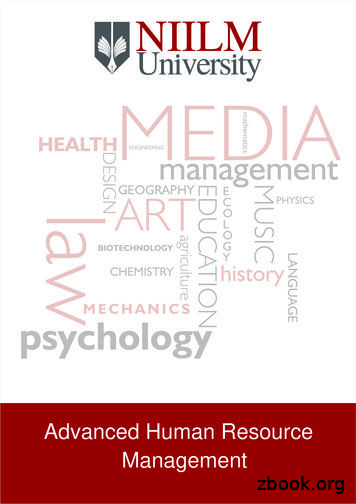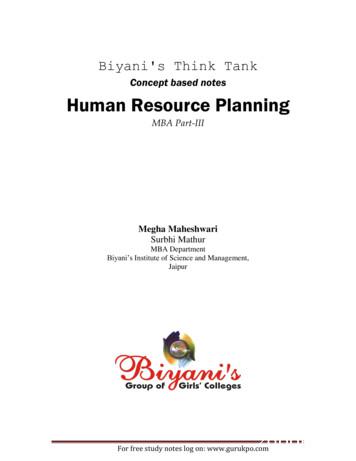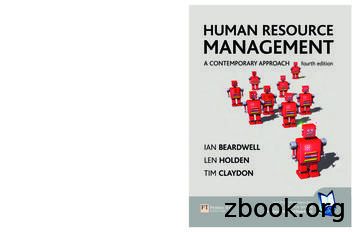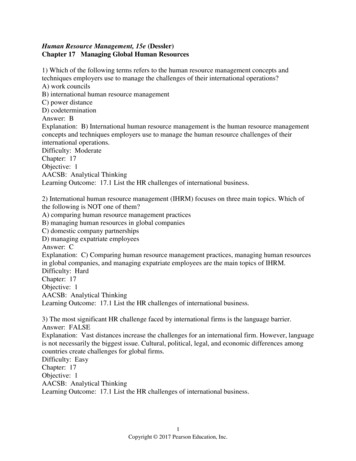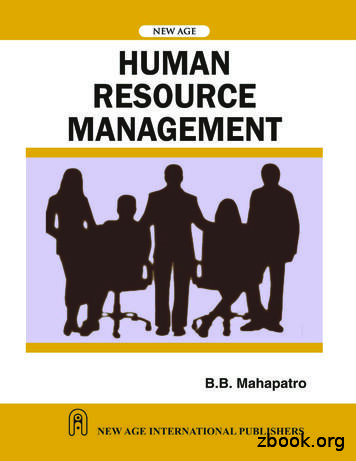Handbook Of Human Resource Management In Government
Condrey.ffirs10/20/042:18 PMPage vSSHandbook ofHuman Resource Managementin GovernmentSecond EditionStephen E. Condrey, Editor
Condrey.ffirs10/20/042:18 PMPage iv
Condrey.ffirs10/20/042:18 PMPage i
Condrey.ffirs10/20/042:18 PMPage iiInstructors are invited to view and downloadthe supplementary Instructor’s Manual for theHandbook of Human Resource Management in Government,Second Edition.The Instructor’s Manual is available FREE on-line.If you would like to download and print out anelectronic copy of the Manual, please visitwww.wiley.com/college/condreyThank you,Stephen E. Condrey
Condrey.ffirs10/20/042:18 PMPage iiiSSHandbook ofHuman Resource Managementin Government
Condrey.ffirs10/20/042:18 PMPage ivConsulting EditorJames L. PerryIndiana University
Condrey.ffirs10/20/042:18 PMPage vSSHandbook ofHuman Resource Managementin GovernmentSecond EditionStephen E. Condrey, Editor
Condrey.ffirs10/20/042:18 PMPage viCopyright 2005 by John Wiley & Sons, Inc. All rights reserved.Published by Jossey-BassA Wiley Imprint989 Market Street, San Francisco, CA 94103-1741www.josseybass.comNo part of this publication may be reproduced, stored in a retrievalsystem, or transmitted in any form or by any means, electronic,mechanical, photocopying, recording, scanning, or otherwise, exceptas permitted under Section 107 or 108 of the 1976 United StatesCopyright Act, without either the prior written permission of thePublisher, or authorization through payment of the appropriateper-copy fee to the Copyright Clearance Center, Inc., 222 RosewoodDrive, Danvers, MA 01923, 978-750-8400, fax 978-646-8600, or on theweb at www.copyright.com. Requests to the Publisher for permissionshould be addressed to the Permissions Department, John Wiley &Sons, Inc., 111 River Street, Hoboken, NJ 07030, 201-748-6011,fax 201-748-6008, e-mail: permcoordinator@wiley.com.Jossey-Bass books and products are available through mostbookstores. To contact Jossey-Bass directly, call our CustomerCare Department within the U.S. at 800-956-7739, outsidethe U.S. at 317-572-3986, or fax 317-572-4002.Jossey-Bass also publishes its books in a variety of electronic formats.Some content that appears in print may notbe available in electronic books.Readers should be aware that Internet Web sites listed inthis work may have changed or disappeared betweenwhen this work was written and when it is read.Library of Congress Cataloging-in-Publication DataHandbook of human resource management in government/Stephen E.Condrey, editor; James L. Perry, consulting editor.—2nd ed.p. cm.Includes bibliographical references and index.ISBN 0-7879-7258-4 (alk. paper)1. Civil service—United States—Personnel management—Handbooks,manuals, etc. I. Condrey, Stephen E., date. II. Perry, James L.JK765.H33 2005352.6'0973—dc22Printed in the United States of AmericaSECOND EDITIONHB Printing 10 9 8 7 6 5 4 3 2 1
Condrey.ftoc10/20/0412:03 PMPage viiSSCONTENTSTables, Figures, and ExhibitsPrefacexixvThe EditorxixThe Contributors xxiIntroduction: Toward Strategic Human Resource Management1Stephen E. CondreyPART ONE: HUMAN RESOURCE MANAGEMENT IN A CHANGING ENVIRONMENT 151 The Changing Role of the Human Resource Office17Carolyn Ban2 Beyond Civil Service: The Politics of the Emergent Paradigms37Donald E. Klingner, Dahlia Lynn3 Radical Civil Service Reform: Ideology, Politics, and Policy 58J. Edward Kellough, Lloyd G. Nigro4 State Civil Service Systems76Keon S. Chivii
Condrey.ftoc10/20/0412:03 PMPage viiiviii CONTENTSPART TWO: THE PUBLIC SECTOR WORKFORCE 955 Staffing the Bureaucracy: Employee Recruitment and Selection 97Steven W. Hays, Jessica E. Sowa6 Toward a More Flexible Public Workforce: Issues and Implications125James R. Thompson, Sharon H. Mastracci7 Valuing Diversity: The Changing Workplace143Mary E. Guy, Meredith A. Newman8 Managing an Aging Workforce: Trends, Issues, and Strategies164Jonathan P. West9 Using Technology in the Workplace189David H. Coursey, Samuel M. McCreary10 Using Volunteers in the Workplace215Jeffrey L. BrudneyPART THREE: MANAGING HUMAN RESOURCES 23911 Public Human Resource Management: An OrganizationalDevelopment Perspective 243David G. Carnevale, Kay Ham12 Practical Strategies for Increasing Ethical Behavior in the Workplace 257Rex L. Facer II, Mark D. Bradbury13 Organizational Investment in Employee Development272Montgomery Van Wart14 Understanding Organizational Climate and Culture295J. Steven Ott, Abdul M. Baksh15 Understanding and Using Conflict in the Workplace326Margaret S. Herrman16 Employee Unions and the Human Resource Management Function 351Robert M. TobiasPART FOUR: THE LEGAL ENVIRONMENT OF HUMAN RESOURCE MANAGEMENT 37517 Human Resource Management Legal IssuesJerry Hartman, Gregory W. Homer, Alisa H. Reff377
Condrey.ftoc10/20/0412:03 PMPage ixCONTENTS18 A Practical Guide to Affirmative Action 403Norma M. Riccucci19 Sexual Harassment in the Workplace423Michele M. Hoyman, Lana Stein20 Understanding the Americans with Disabilities Act440David PfeifferPART FIVE: MOTIVATING, ASSESSING, AND COMPENSATING EMPLOYEES 46521 The Role of the Manager in Employee Motivation 469Arie Halachmi, Theo van der Krogt22 Designing Effective Performance Appraisal Systems499Dennis M. Daley23 Effective Job Analysis Methods528Mark R. Foster24 A Practical Guide to Conducting Assessment Centers 556Charles R. Swanson, Mark R. Foster25 Work Management and Job Evaluation Systemsin a Government Environment 576Gilbert B. Siegel26 Designing and Creating an Effective Compensation Plan 598Gilbert B. SiegelPART SIX: TOOLS FOR INTEGRATING HUMAN RESOURCESINTO THE ORGANIZATIONAL MISSION 61927 Benchmarking Performance623David N. Ammons28 Strategic Planning for Human Resource Managers 648Roger G. Brown, Mary Maureen Brown29 A Guide to Practical Human Resource Research 669Gary E. Roberts30 Human Resource Consultants and Outsourcing:Focusing on Local Government 701Glenn W. Rainey Jr.ix
Condrey.ftoc10/20/0412:03 PMPage xx CONTENTS31 Employee Benefits: From Health Care to Pensions735N. Joseph Cayer32 The Role of Human Resource Professionals in the Budgeting Process 754Douglas J. Watson, Catherine C. ReeseConclusion: Toward Effective Human Resource ManagementStephen E. CondreyName Index 781Subject Index 789776
Condrey.ftoc10/20/0412:03 PMPage xiSSTABLES, FIGURES,AND EXHIBITSTABLESI.1 A Comparison of Four Models of Public HumanResource Management 92.1 Evolution of Public HRM Systems and Values in the United States 404.1 State Personnel Agencies 784.2 Number of Job Classifications, 1996 and 2003 866.1 U.S. Workforce by Category of Worker, 1995–2001 1296.2 Work Years (Full-Time Equivalents) in Executive Branch Agencies(excluding the U.S. Postal Service), 1987–2000 1327.1 U.S. Population Demographics, 2000 1457.2 Comparison of Government Workforce to Total Civilian Labor Forceand Workforce, 2000 1467.3 Federal Civilian Workforce Compared to Overall CivilianLabor Force, 2002 1467.4 Gender Composition of the Labor Force, 1966–2000 1477.5 Labor Force Participation for Married Women with ChildrenUnder Age Eighteen and Husbands Present 1487.6 Labor Force Participation Rate by Gender and Age, 1950–2000 1497.7 Percentage of Federal Workers Who Say They Were Denieda Job, Promotion, or Other Job Benefit Because of UnlawfulDiscrimination 156xi
Condrey.ftoc10/20/0412:03 PMPage xiixii TABLES, FIGURES, AND EXHIBITS8.1 Percentage of Younger and Older Workers in the United States,by Level of Government and Sector, 2001 1708.2 Best Practices in Federal Agency Succession Planning 17418.1 Key U.S. Supreme Court Actions or Decisions on AffirmativeAction 40819.1 Sexual Harassment in the Armed Services: Percentage ofRespondents Reporting at Least One Incident in the Past Year 42421.1 Three Sets of Motivational Needs 48024.1 Harborville Police Department Tentative Dimension-ExerciseMatrix 56927.1 Selected Standards for Iowa’s Public Libraries 63227.2 Process Flowchart Symbols 64028.1 Tools Employed in the Planning Cycle 66631.1 Public Employee Benefits Summary 73832.1 Annual Cost Savings for Fire Stations Staffed with StudentFirefighters 76032.2 Cost of Implementation of the City of Big Spring Personnel Project 762FIGURES26.128.128.228.328.428.5Constructing Pay Ranges 609The Strategic Planning Cycle 651The Planning Wheel 652A Police Department Planning Wheel (Rings 1, 2, and 4) 655Police Department Planning Wheel (Rings 1 Through 4) 659Detail of Step 3 of the Police Department Planning Cycle 14.2City Managers’ Descriptions of Achievements and Obstacles 180Sample Job Description for a Volunteer Position 229IPMA-HR Principles and Values Statement 262Sample Ethics Training Outline 266Changing Notions of Human Resource Development 275Checklist to Determine the Best Organizational AssessmentStrategy 278Examples of Two Approaches to Management Training Programs:Performance Gap and Comprehensive 282Checklist of Possible Needs of Individuals 283Checklist of Instructional Methods by Instructional Family 288Organizational Climate Index 305Survey of Organizational Climate 307
Condrey.ftoc10/20/0412:03 PMPage xiiiTABLES, FIGURES, AND EXHIBITS15.1 An Analysis of Mediator Knowledges and Skills 33918.1 Sample Table of Contents and Language for an Affirmative ActionPlan for Midtown, USA 41519.1 Athens-Clarke County Government Policy Manual 43222.1 Employee Performance Evaluation Form 51022.2 MBO Appraisal 51522.3 Corrective Counseling Report 52023.1 Sample PAQ Items 54223.2 Knowledge and Skills for the Position of Police LieutenantDetermined Through Task Analysis 54723.3 Two Scales That Might Be Used in Task Analysis Ratings 54923.4 Excerpts from the Uniform Guidelines on Employee SelectionProcedures 55124.1 Harborville Police Department 2004 Lieutenants’ AssessmentCenter Roll-Call Training Exercise 56125.1 Career Path Identification by Classification and Current Grade 58725.2 Sample Job Description 59325.3 Sample Guide Chart 59526.1 Five Examples of Salary Range Alternatives 61327.1 Oregon Benchmarks 62727.2 Reporting Progress on Oregon’s Benchmarks: Benchmarks40 and 41 62827.3 Benchmarks for Prompt Referral of Job Candidates 63427.4 Benchmarks for Prompt Position Audits for Reclassificationand Compensation Requests 63627.5 Benchmarks for Prompt Hearing and Resolution of EmployeeGrievances: Selected Cities 63727.6 Process Chart: Requisitioning Small Tools 64227.7 Process Chart: Proposed Process with Improvements 64328.1 Useful Tools for Identifying Vision, Values, and Mission 65329.1 Sample Employee Attitude Survey Schedule (Pencil-and-PaperVersion) 67329.2 Sample Employee Attitude Survey 67429.3 Factors That Reduce Survey Reliability and Validity 67829.4 Sample Questions for Use in a Workplace Ethics Audit Interview 68329.5 The Interview Development and Implementation Process 68429.6 Conducting a Focus Group 68729.7 Preamble and Questions for Use in a Focus Group onServant-Leadership 68829.8 Steps in a Return-on-Investment Analysis 69329.9 Return-on-Investment Analysis for a Religious DiversityTraining Program 694xiii
Condrey.ftoc10/20/0412:03 PMPage xivTo Samantha
Condrey.fpref10/20/0412:02 PMPage xvSSPREFACEOver the past several decades, the once staid field of public personnel administration has emerged as the rapidly changing field of human resourcemanagement. Although some may consider this a mere difference innomenclature, court decisions concerning test validation and employee rights,legislation such as the Americans with Disabilities Act of 1990, technologicaland demographic changes in the workplace, and political pressures for reform,reinvention, outsourcing, decentralization, downsizing, and privatization havethrust the human resource manager into a pivotal position in rapidly changinggovernmental organizations. These changes have transformed personnel administration from an insulated administrative function performed in relative isolation to a crucial managerial function performed at many organizational levels.Since the first edition of this book was published in 1998, the field has continued to evolve. The most important changes are the increased calls for privatization of government services and the outsourcing of public human resourcemanagement functions. The states of Georgia and Florida have turned to moreprivate-sector-oriented models to administer all or parts of their civil servicesystems. The newly formed federal Transportation Security Administration outsources most essential human resource management functions.The Handbook of Human Resource Management in Government is designedto provide the reader—whether a student, scholar, or seasoned human resourcemanager—with a reference point from which to assess the needs and challengesxv
Condrey.fpref10/20/0412:02 PMPage xvixvi PREFACEof his or her organization in the current public human resource managementenvironment.AUDIENCEPractitioners argue that much of what is printed in academic journals is obtuseand does not inform effective human resource management practices. Conversely, many academic researchers tend to discount the collective knowledgeof practicing human resource managers. Of course, the truth lies somewherebetween these two extremes. Much academic research supports effective humanresource management practices, and there is much to be learned from managerswho have spent years managing public human resource management systems.Thus the aim of the Handbook is to bring together a collection of well-researched,timely, and informative materials dedicated to providing practical guidance andadvice for practicing managers and students in the field and to maintaining contextual relevance for those who study and teach human resource management.OVERVIEW OF THE CONTENTSThe Handbook is divided into six parts. Each part clusters around a specifictheme; however, many topics are reinforced throughout the book. The first part,“Human Resource Management in a Changing Environment,” provides thereader with an appreciation of the current prospects and challenges of the public human resource management profession. This part begins with a discussionof how the role of the human resource manager is changing in reaction to thenew organizational milieu. It also includes overviews of state civil service systems and the organizational and political environment of public human resourcemanagement. Part One also includes discussion of the “radical” civil service reforms of the past decade.Part Two, “The Public Sector Workforce,” concerns staffing and managingthe public sector workplace. The part begins with a discussion of recruitmentand selection techniques and continues with a discussion of flexible workarrangements, diversity, managing an aging workforce, technological changesand influences, and the use of volunteers in the workplace.Part Three, “Managing Human Resources,” provides information on a widearray of organizational topics of concern to public human resources managers. It begins with a discussion of organizational development techniquesand explains how, when properly employed, they can be used to strengthenpublic organizations. Other chapters discuss creating a workforce environ-
Condrey.fpref10/20/0412:02 PMPage xviiPREFACEment supportive of ethical behavior, employee training and development, organizational culture and climate, and understanding and using conflict and employee unions.Part Four, “The Legal Environment of Human Resource Management,” provides the reader with an appreciation for the legal context in which human resource management is practiced in public organizations. The part begins withan overview of the major statutes affecting the practice of public human resource management. The special constitutional rights and responsibilities ofpublic employees and employers are addressed, as is the need to retain qualified legal counsel. Three separate chapters provide practical advice concerningequal employment opportunity and affirmative action, sexual harassment in theworkplace, and the Americans with Disabilities Act.Part Five, “Motivating, Assessing, and Compensating Employees,” beginswith an overview of the different theories and methodologies for rewarding andmotivating public employees. Individual chapters lend specific guidance on constructing a position classification system, designing and creating an effectivecompensation system, designing a performance appraisal system, and conducting job analyses and assessments.Part Six, “Tools for Integrating Human Resources into the Organizational Mission,” maps out avenues human resource managers can take to break out of theoften self-imposed box that has constricted the profession, and it describes instruments they can use to become more involved in the overall management oftheir organizations. Individual chapters furnish empirically based guidance onbenchmarking and assessing organizational productivity; conducting strategicplanning and analysis; conducting human resource management research; evaluating, hiring, and managing human resource consultants; and performing essential budgeting functions.ACKNOWLEDGMENTSI would like to thank the many people who helped me in bringing this volumetogether. James L. Perry, editor of the Jossey-Bass Public Administration Series,and Dorothy Hearst, senior editor at Jossey-Bass, provided guidance, insight,and encouragement at many crucial junctures in the Handbook’s conception,development, and revision. Three anonymous reviewers went well beyond thecall of duty in their thoughtful, thorough, and instructive comments on each ofthe Handbook chapters. Allison Brunner, senior editorial assistant at JosseyBass, was always available to facilitate the editorial process. I appreciate the assistance of senior production editor Xenia Lisanevich and copyeditor BruceEmmer in the editing and production process.xvii
Condrey.fpref10/20/0412:02 PMPage xviiixviii PREFACEJason Fleury, program specialist with the Carl Vinson Institute of Government,played a very significant role as my assistant during the entire process of revising the Handbook. His assistance is greatly appreciated. Paul Battaglio, doctoralcandidate in public administration, and Dan Lasseter, Latatia Hunt, ChristineLedvinka, and Linda Seagraves, of the Vinson Institute staff, also provided valuable assistance at various points in the process of preparing the Handbook.Thanks to each of you.Each of the chapter authors is to be commended for his or her efforts in writing an insightful, practically oriented chapter for the Handbook. Without exception, they were thoughtful and responsive throughout the process.My sincere gratitude to each of you.Athens, GeorgiaOctober 2004Stephen E. Condrey
Condrey.flast10/20/0412:02 PMPage xixSSTHE EDITORStephen E. Condrey is senior associate and program director for human resourcemanagement with the University of Georgia’s Carl Vinson Institute of Government.He is also adjunct professor of public administration and policy in the School ofPublic and International Affairs at the University of Georgia. He has over a quarter of a century of professional experience in human resource management andhas consulted nationally and internationally with more than five hundred organizations on personnel-related issues. He presently serves as managing editor of theReview of Public Personnel Administration, and formerly served on the publications board of the American Society for Public Administration (ASPA) and the editorial boards of Public Administration Review and Public Personnel Management.He is the 1998 recipient of the University of Georgia’s Walter Barnard Hill Awardfor Distinguished Achievement in Public Service and Outreach and was namedDistinguished Hill Fellow in 2004. Condrey is the immediate past chair of theASPA’s Section on Personnel Administration and Labor Relations and holds theIPMA-CP designation from the International Personnel Management Association.He is also the president of Condrey
16 Employee Unions and the Human Resource Management Function 351. Robert M. Tobias. PART FOUR: THE LEGAL ENVIRONMENT OF HUMAN RESOURCE MANAGEMENT 375. 17 Human Resource Management Legal Issues 377. Jerry Hartman, Gregory W. Homer, Alisa H. Reff.
human resource functions while keeping them satisfied in their work. It covers a wide range of chapters on human resource management such as human resource functions, performance management and human resource development and empowerment. This module serves the purpose of a resource handbook for carrying out training on Human Resource Management
Human Resource Management Human Resource Policy QUADRANT-I Module 4: Human Resource Policy 1. Learning Outcome 2. Definition 3. Employee understanding on HR Policy 4. Benefits of policy 5. Specific Personal policies 6. Responsibility for policy making 7. Formulation of Human Resource Policy 8. Principles 9. Procedures 10. Programs 11. Summary 1.
Human Resource Management Question Answer Bank MBA-203 Q.1 What is Human Resource Management Human Resource Management is a process, which consists of four main activities, namely, acquisition, development, motivation, as well as maintenance of human resources. Scott, Clothier and Spriegel have defined Human Resource Management as that
1.1.2 Evolution of Human Resource Management 1.1.3 Human Resource Management: Nature 1.1.4 Human Resource Management: Scope 1.1.5 Human Resource Management: Objectives 1.2 Functions of HRM 1.3 Growing Importance of HRM Functions 1.3.1 Factors Contributing to the Growing Importance of HRM 1.4 Concepts and Essential of Management
Ans Human resource planning can be defined as the process of identifying the number of people required by an organization in terms of quantity and quality. All human resource management activities start with human resource planning. So we can say that human resource planning is the principle/primary activity of human resource management.
Human resource management: the state of the debate 24 Summary 27 Activity 28 References and further reading 29 2 Strategic human resource management Nicky Golding 32 Objectives 32 Introduction to strategic human resource management 32 Understanding the business context 34 Approaches to the strategy-making pr
B) international human resource management C) power distance D) codetermination Answer: B Explanation: B) International human resource management is the human resource management concepts and techniques employers use to manage the human resource challenges of their international
1.3 Definition of Human Resources Management 3 1.4 A New Mandate for Human Resources 4 1.5 Changing Role of the Human Resource Management 5 1.6 Managing human resources in the emerging scenario 7 1.7 Evolution of Management of Human Resources: An Indian Perspective 10 References 16 2. THE CONCEPT, SCOPE AND FUNCTION OF HUMAN RESOURCE OF .




